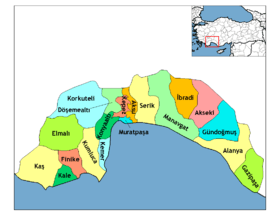Kepez, Antalya
| Kepez | |
|---|---|
 Kepez | |
| Coordinates: 36°55′N 30°41′E / 36.917°N 30.683°ECoordinates: 36°55′N 30°41′E / 36.917°N 30.683°E | |
| Country | Turkey |
| Province | Antalya |
| Government | |
| Elevation | 289 m (948 ft) |
| Population (2012)[1] | |
| • Urban | 425,794 |
| • District | 433,961 |
Kepez is a municipality and district governorate in Greater Antalya, Turkey. Antalya is one of the 30 metropolitan centers in Turkey with more than one municipality within city borders. In Antalya there are five second-level municipalities in addition to Greater Antalya (büyükşehir) municipality.
Geography
Kepez is a part of Greater Antalya proper. The name Kepez means rocky area[2] referring to original (before urbanization) Kepez landscape which consisted of rocky plateau. The urban population of Kepez was 425,794 [3] as of 2012.
History
Kepez, like the rest of Greater Antalya was wrested between the Seljuk Turks and the Byzantines during the 11th and 12th centuries. After 1216, Kepez was incorporated into Seljuk realm. After the disintegration of Seljuks the area was a part of the Turkmen beylik of Teke. In 1389, the city was captured by the Ottoman Empire. After the defeat of Ottomans in the Battle of Ankara in 1402, Kepez area was annexed by Karamanids, another Turkmen principality up to 1415. During this brief period a Turkmen tribe named Varsak was settled around Kepez.[4] After 1415 Antalya area became an Ottoman territory. During the Republican era the scattered population around Kepez increased. After Antalya was declared as the metropolitan center, Kepez municipality was incorporated into Greater Antalya in 1993 and the corresponding district governorate was established in 2008.
Archaeology
The ancient city of Lyrboton Kome (Ancient Greek: Λυρβωτῶν κώμη), located in Antalya's Kepez district on a hill in Varsak [5] was discovered in 1910 by European archaeologists.[6] The ancient city was an important olive oil production center in the region.[7] The village had close ties to Perge.[8] The ancient city became a settlement during the Hellenistic era but the area grew during the era of Roman Emperor Domitian in the first century.[9]
Kepez today
Antalya bus terminal and a cement factory as well as a hydroeletric plant are in Kepez. Although not a seaside district, nevertheless in Kepez there are a number of touristic attractions like Düden Waterfalls and zoo of Antalya. On several locations (like Kepezüstü) the tourists can enjoy the scenery of Antalya.
Rural area
There are 6 villages in the rural area of Kepez district. The total population of the district (urban and rural) is 433,791.[3]
References
- ↑ "Population of province/district centers and towns/villages by districts - 2012". Address Based Population Registration System (ABPRS) Database. Turkish Statistical Institute. Retrieved 2013-02-27.
- ↑ Mayor's page (in Turkish)
- 1 2 Statistical Institute Archived 2015-01-22 at the Wayback Machine.
- ↑ Governor's page (in Turkish)
- ↑ Antalya’s Lyrboton Kome ready to open to visitors
- ↑ Ancient city witholds the secrets of olive oil
- ↑ Ancient city Lyrboton Kome discovered under wild plants in Antalya
- ↑ Archaeologists Find Ancient Olive Press
- ↑ Anatolia’s oldest known olive oil press found in Antalya
